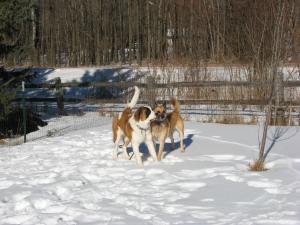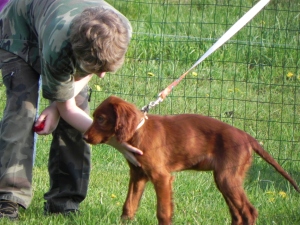
The excitement, the expectations, the changes can all be overwhelming and can all be turned into upset, disappointments and even all the way to real bad if not handled with finesse.
In this article I’ll list 7 things you can do to make it more likely dog vs pup and dog vs child will go well and have everybody liking each other.
There are certainly resident dogs who do fine no matter what is thrown at them, and if so lots of times they are lucky enough to have the situation that works – escape options, extra people who offer just the right amount of support, plenty of early socialization so they are not scared or worried and perhaps have laid-back temperaments so they really don’t care much. Hopefully you know if your resident dog isn’t one of these dogs and if you aren’t sure, act as if he isn’t. Taking more care with the introductions will not hurt anything and may save much grief.
When it’s a new dog or pup that the older dog won’t tolerate well often families sent the newbie on his way. This doesn’t have to happen if they’re willing to control the meetings/contacts better or for much longer. I’ve seen dogs who initially were quite upset by each others presence if given time and prevented from aggressive displays come to like and play with each other (I’ve got two such dogs, and a cat, living in my house right now – and it took about 7 or 8 months of being careful with the environment to get them more and more comfortable, and I still watch for bad situational set-ups).
Of course, if it’s the baby, then the dog is banished, either from the family totally or from the house or from certain areas. A family loss in any event.
1. Low key, non-confrontational introductions. (Don’t start with child or pup running or grabbing or crawling at dog or the child/baby screaming/crying upset or any version of bursting through a door). For babies, offer their scent on some clothing first and offer it non-excitedly. Just put the baby-scented item down and let the dog smell and then go on to other things. A sleeping baby’s foot is also a good thing to smell. We always want safety for the little one, so make sure of it.
Let dog see children from a distance, let dog walk by children that are going in the same direction, let calm child drop food. Let dog walk and pup walk and you walk (movement forward in a group is good). Let dog approach, don’t pursue dog or drag the dog closer. Let dog leave if they want to, have a way for them to escape if they need to. Observe how the dog is acting – where is their tail, ears, eyes and how does their mouth/muzzle look? Loose body posture or tight? Wary or relaxed? We want loose and relaxed.
2. Play-acting practice. Let dog see mom-to-be carting a bundle, rocking with doll and let him check this out. Practice low-key, practice without excitement, practice rewarding disinterest. Reward dog for going and lying down out-of-the-way. Practice with the stroller (with doll) going for walks. Have another family member pick up lots of mom-to-be’s dog duties so he won’t be so surprised that she isn’t paying much attention to him.
Meet and greet with other dogs (find dog friendly dogs) – how does your dog do with them? Which kinds of meet and greet worked best for your dog? Use this knowledge when adding a new dog to the family.
3. Use confinement – gates, crates, kennels, doors. Create safe zones. There is no reason to rush into having everybody free in the room/house at the same time. If the dog’s free in the area, pup or baby is elsewhere and vice versa. The longer they are in the same household with no negative, exciting incidents the more likely everything will continue to go well.
If your dog isn’t used to being confined in the house, start practicing before the baby arrives … no need for barking, whining, pawing when everyone needs quiet to sleep.
4. Practice control cues – sit, down, go, stay, come. This is for both pup and resident dog. The more things they know to do well the better they will be able to cope and easier they are to have around. Use positive training techniques as these will help create confidence instead of anxiety. Offering food is calming and can change emotions toward more positive. I usually have kids toss or drop food to prevent pull away hand motions that encourage pups to grab.
5. Practice respectful child/parent and actively supervise. For child – if they are old enough to understand, set up rules on how to interact with the dog, places where child doesn’t get to bother the dog. For parents – parents need to know what are reasonable child/dog interactions and not encourage the child to do things that are abusive to the dog, (no hugging neck or rear, no kissing nose, no riding or climbing on dog, no poking at eyes or ears or mouth, kicking, hitting, jumping on … etc.) See Doggone safe.com website.
Puppies need to be respectful of older dogs too. Older dogs will often vocally and physically prove this to a pup who is jumping on them or repeatedly bothering them. Usually this is a quick outburst after several warnings, and the pup may fall down and flip belly up or go yipping away. This is right action by the older dog. Intervening in this is not recommended because then the pup may well continue to be obnoxious and the older dog may suffer through it until they just can’t stand it anymore. If your older dog is continuing to tolerate bad puppy behavior, give them a safe area to go to get away and prevent your new dog from harassing them. Find some other older dog (often female) who will help your pup have better dog manners over several play dates.
6. Play games that encourage cooperation. Give the dog some tasks that he can do well and reward him for them. Avoid setting up competitions for resources (food, toys), instead have each do his part of the game or task (keep food bowls, bones, toys separate or put up). Note that if the dogs start playing, let them, but intervene if it is obviously too rough … and I have rules about wild play in the house – wild play belongs outside.
7. If there is aggression display intervene by distracting, intervene with water if there is a dogfight, if not intervene by getting them to move on … Then review what went wrong, what was the set up that made aggression likely, what do you need to do in the meantime to manage it and what needs to be trained to fix it? (note that aggression met with aggression on the owners/handlers part has a significant likely hood of increasing the aggression/fear and the behavior that was unwanted). Having a scuffle or even several does not mean they can’t ever be friends, just don’t let it keep happening by knowing what precedes it.
Children and growling dogs? Children need to know that growls mean quit it or else. Adults need to know that a dog that growls and isn’t playing is giving a vocal warning that things aren’t OK with them. Reprimanding the dog harshly is a poorly thought out reaction, what you really want is a dog that can cope and has other good strategies. Many dogs lick children in the face to get them to go away, many dogs leave and go to their safe place (if they can find one), some dogs know how to distract children and will steal something from them to change what they’re doing and some dogs with unsupervised children have taught them with controlled nips or pushy rowdiness (not something I’d recommend).

What I like for the above is a safe zone that the dog knows he can go to and get away from kids and also increasing the dog’s tolerance of children by reducing their fears (games with kids where the dog gets to approach or find them and the child stays still or moves away and rewards the dog). In the process the child gets taught better games to play with the dog and what not to do with the dog.
Setting up the introductions, practicing the parts of things the dog will need to know or do, managing the rest until it can be fixed or modified can make most household additions quite workable and pleasant without sacrificing any members of them.
Interesting read. When I was pregnant with my first child, Sara I used a book called Tell Your Dog You’re Pregnant: An essential guide for dog owners who are expecting a baby. It was really helpful and came with a baby sounds and toy noises. Max (my fur child!) took some time to get used to the sounds but the book helped on how to do it. It gave me advice on what changes will occur and how to prepare my Max for them. It also talked about the causes for aggression and why it might occur and how to avoid it. It is written by a vet behaviorist too so it cover health issues as well – I got it from http://www.babyandpet.com.au – mayb that will help someone else!
LikeLike
Thanks, additional references are always helpful. I appreciate your comment.
LikeLike